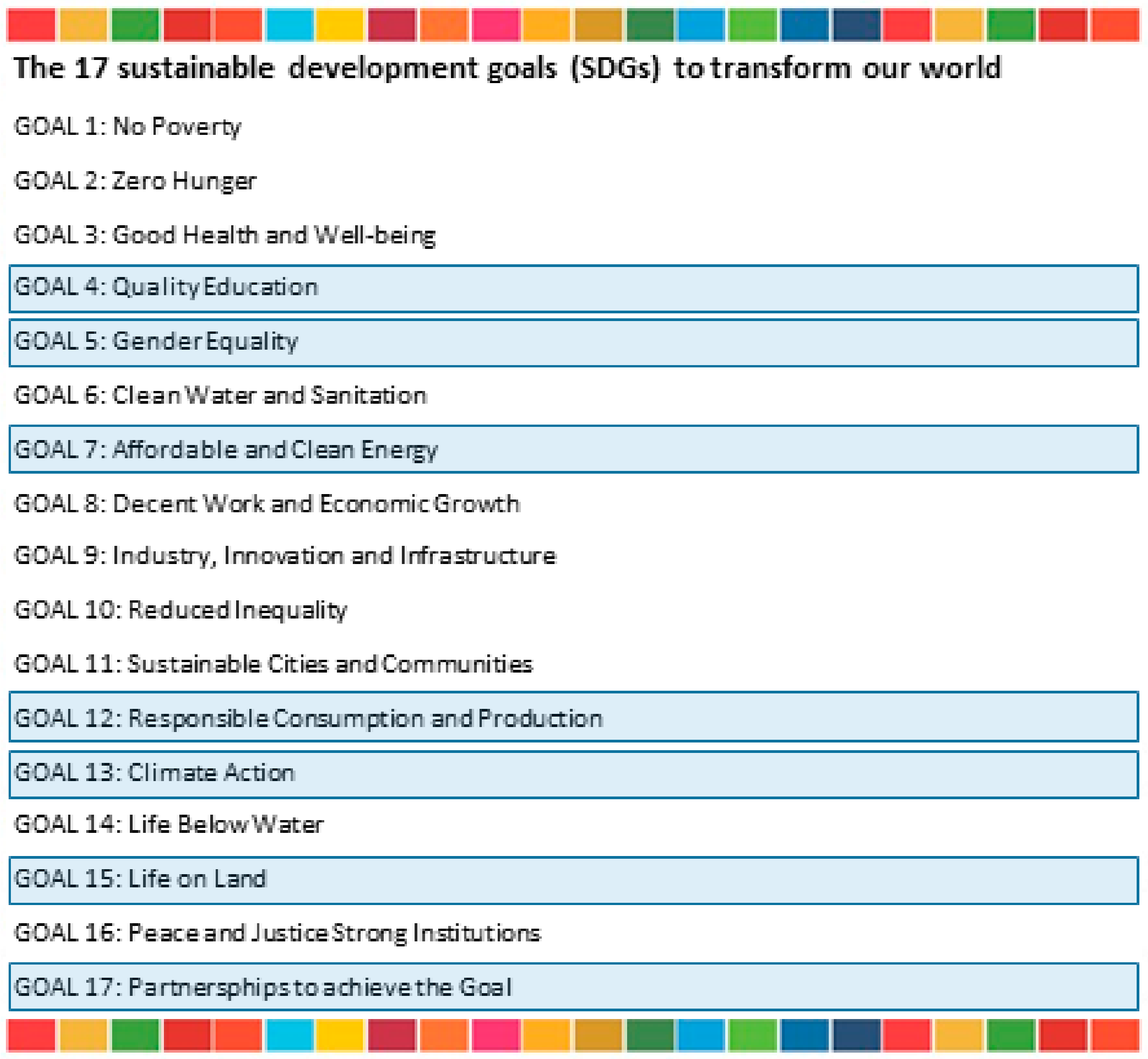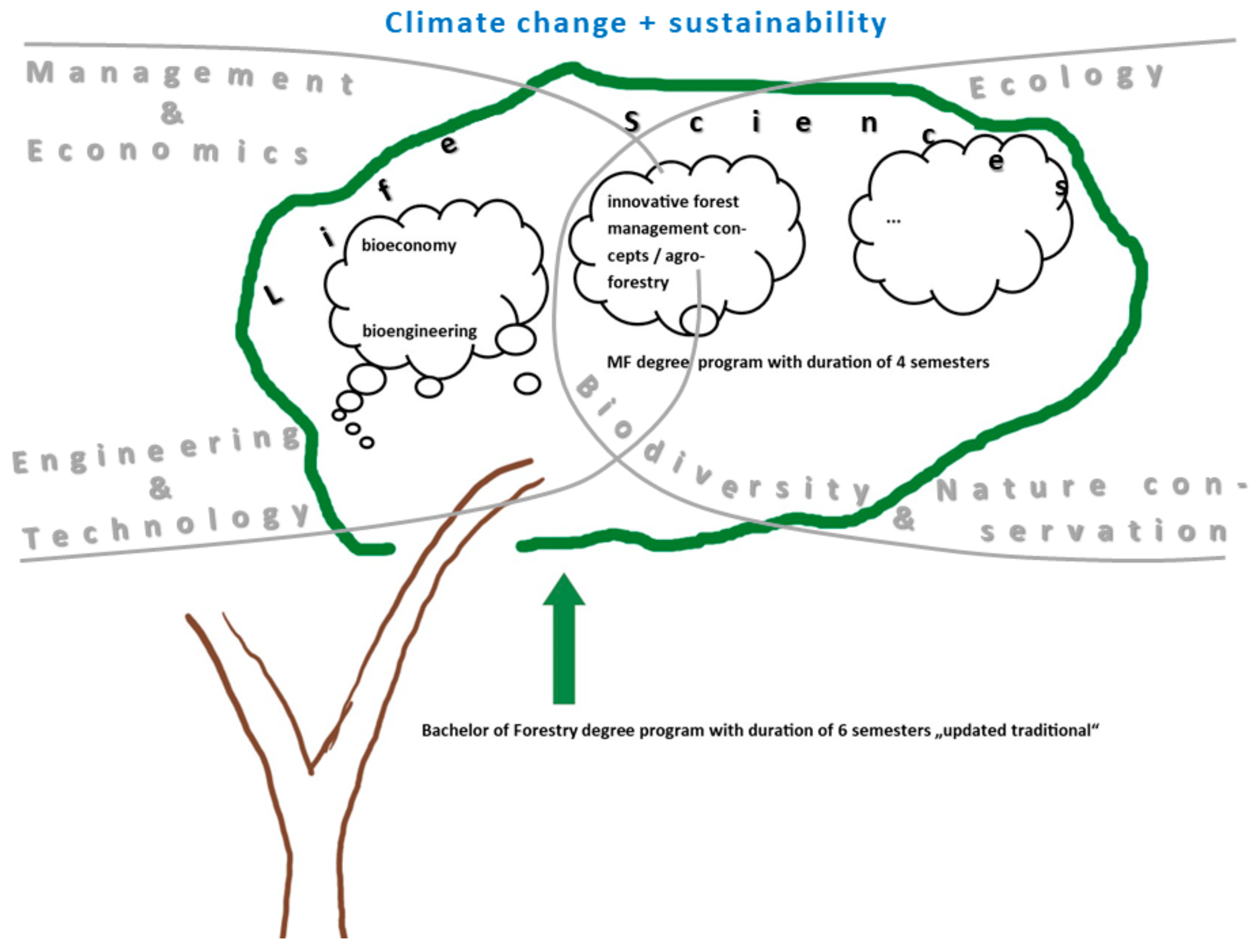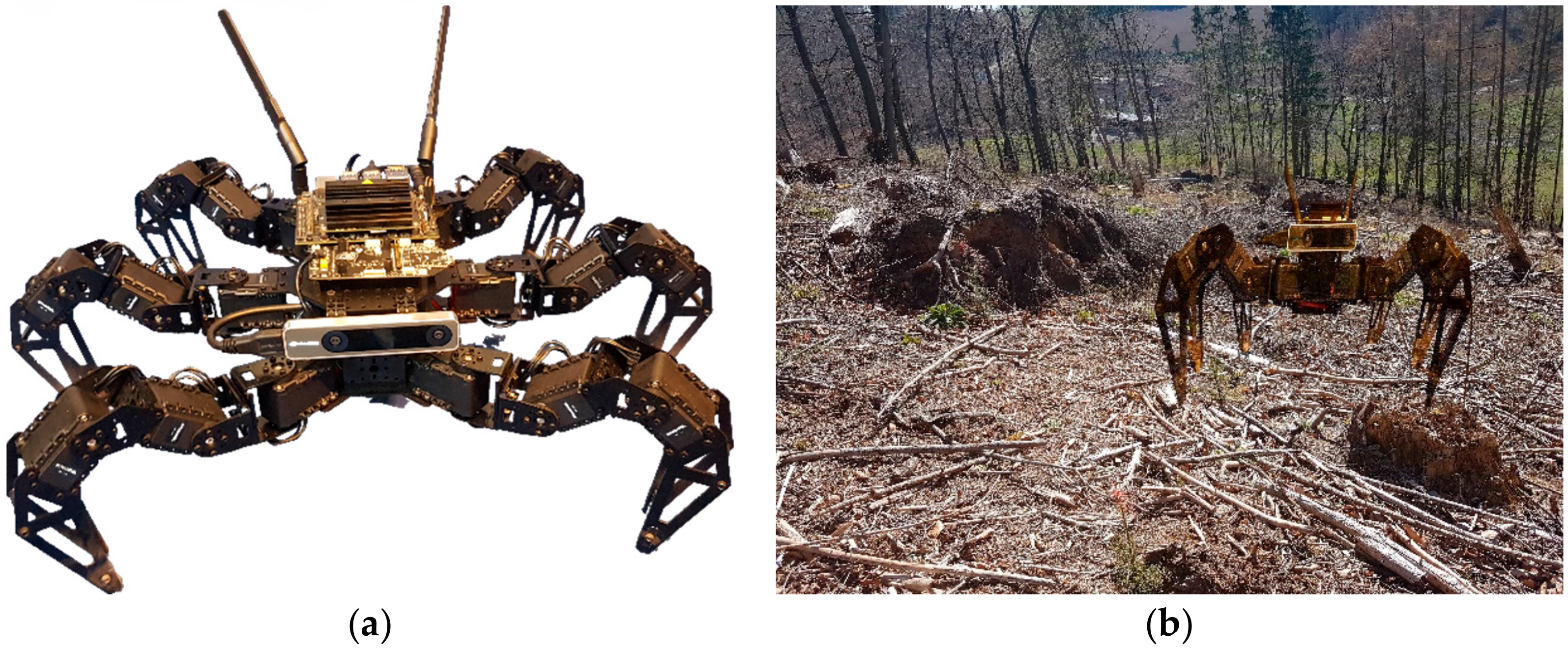Development of an Interdisciplinary Master of Forestry Program Focused on Forest Management in a Changing Climate
Abstract
:1. Introduction
2. Methodical Approach
2.1. Needs—Establishment of a Knowledge Transfer Nework (KTN)
2.2. Target Group
2.3. Goal Model of Training Program
2.4. Content Objectives
3. Results
- acquire skills in how fallen timber that occurs in abundance in connection with extreme weather events, insect outbreaks, and introduced novel disturbances can be used innovatively (e.g., innovative wood products made from lignin (wood polymer), starch, glucose, plant-based oils, waxes, and minerals; innovative products made from biochar, i.e., charcoal used as a soil amendment for both carbon sequestration and soil health benefits);
- deepen knowledge on how they can save energy in forestry operations and timber harvesting and how they can act in a more resource-efficient and energy-efficient manner (improvement in energy efficiency);
- deepen knowledge on how the entire value chain can be optimized (e.g., cascading use of wood products [39]; cascading use of biomass; material flow management; logistics; project management);
- deepen knowledge on how forest carbon stock can be optimized (e.g., carbon in above-ground biomass; carbon in below-ground biomass; carbon in deadwood; carbon in litter; soil carbon; potential savings in carbon equivalents through forest bog restoration; biomass and carbon sequestration in plantations etc.);
- take advantage of a constant, newly established research training group;
- complete their degree with research cooperation partners abroad.
4. Discussion
- ensures long-term prospects for its temporary research assistants and optimizes routines in consecutive projects;
- supports the possibilities of purposeful international cooperation and research projects, such as currently in a transhemispheric, transcontinental, and transatlantic cooperation with Patagonia [26];
- supports interdisciplinary research and development of new and novel methodologies for adapting forestry and forests to climate change;
- enables cooperation with other research platforms of the university, such as Plasma for Life, in order to apply the resource-saving plasma technology to wood products [41];
- enables a wide-ranging interaction between robotics and forestry science, e.g., in the reforestation or digitization of forests [42];
- supports the pioneering MF degree program with its research orientation and specifically integrates the academic staff and the final theses of the master’s students into the research.
5. Conclusions
Author Contributions
Funding
Acknowledgments
Conflicts of Interest
References
- Fritsche, U.R.; Eppler, U.; Iriarte, L.; Laaks, S.; Wunder, S.; Kaphengst, T.; Wolff, F.; Heyen, D.; Lutzberger, A. Resource-Efficient Land Use—Towards a Global Sustainable Land Use Standard (GLOBALANDS); Umweltbundesamt: Dessau-Rosslau, Germany, 2015; Volume 82, pp. 1–99. [Google Scholar]
- Spathelf, P.; Stanturf, J.; Kleine, M.; Jandl, R.; Chiatante, D.; Bolte, A. Adaptive measures: Integrating adaptive forest management and forest landscape restoration. Ann. For. Sci. 2018, 75, 55. [Google Scholar] [CrossRef] [Green Version]
- Sustainable Forest Management and Climate Change Risks—CIRSD. Available online: https://www.cirsd.org/en/see-views/sustainable-forest-management-and-climate-change-risks (accessed on 15 March 2020).
- Keenan, R.J. Climate change impacts and adaptation in forest management: A review. Ann. For. Sci. 2015, 72, 145–167. [Google Scholar] [CrossRef] [Green Version]
- The Changing World of Forest Education: Global Trends? Available online: http://www.fao.org/3/XII/0928-C1.htm (accessed on 21 April 2020).
- Special Issue “Nonantecedent Stress Impacts on Forest Ecosystems”. Available online: https://www.mdpi.com/si/forests/Nonantecedent_Stress (accessed on 21 April 2020).
- Thom, D.; Seidl, R. Natural disturbance impacts on ecosystem services and biodiversity in temperate and boreal forests. Biol. Rev. 2016, 91, 760–781. [Google Scholar] [CrossRef] [PubMed]
- Senf, C.; Müller, J.; Seidl, R. Post-disturbance recovery of forest cover and tree height differ with management in Central Europe. Landscape Ecol. 2019, 34, 2837–2850. [Google Scholar] [CrossRef] [Green Version]
- Higher Education Pact. 2020. Available online: https://www.research-in-germany.org/en/research-landscape/r-and-d-policy-framework/higher-education-pact-2020.html (accessed on 18 April 2020).
- Schoene, D.H.F.; Bernier, P.Y. Adapting forestry and forests to climate change: A challenge to change the paradigm. For. Policy Econ. 2012, 24, 12–19. [Google Scholar] [CrossRef]
- Bishop, J.; Kapila, S.; Hicks, F.; Mitchell, P.; Vorhies, F. New Business Models for Biodiversity Conservation. J. Sustain. For. 2009, 28, 285–303. [Google Scholar] [CrossRef]
- CEM Work on Nature-Based Solutions | IUCN. Available online: https://www.iucn.org/commissions/commission-ecosystem-management/our-work/nature-based-solutions (accessed on 14 March 2020).
- Envision2030: 17 Goals to Transform the World for Persons with Disabilities. Available online: https://www.un.org/development/desa/disabilities/envision2030.html (accessed on 1 June 2020).
- Darling-Hammond, L. Research on Teaching and Teacher Education and Its Influences on Policy and Practice. Educ. Res. 2016, 45, 83–91. [Google Scholar] [CrossRef] [Green Version]
- Course of Studies Bachelor of Science (BSc) Forestry | HAWK. Available online: https://www.hawk.de/en/studies/courses-of-study/bachelor-science-forestry-gottingen (accessed on 11 May 2020).
- Murtonen, M.; Salmeto, H. Broadening the Theory of Scientific Thinking for Higher Education. In Redefining Scientific Thinking for Higher Education: Higher-Order Thinking, Evidence-Based Reasoning and Research Skills; Murtonen, M., Balloo, K., Eds.; Springer Nature: Cham, Switzerland, 2019; pp. 3–30. [Google Scholar]
- Darling-Hammond, L.; McCloskey, L. Assessment for Learning around the World: What Would it Mean to Be Internationally Competitive? Phi Delta Kappan 2008, 90, 263–272. [Google Scholar] [CrossRef]
- European Qualifications Framework (EQS). Available online: https://www.cedefop.europa.eu/en/events-and-projects/projects/european-qualifications-framework-eqf (accessed on 11 May 2020).
- Early, Rolling, and Regular: Understanding Application Options. Available online: https://www.ivywise.com/ivywise-knowledgebase/resources/article/early-rolling-and-regular-understanding-application-options/ (accessed on 11 May 2020).
- Do Early Birds Get An Edge in Admissions? Available online: https://www.humbacheducationconsulting.com/early-bird-admissions (accessed on 11 May 2020).
- The Early Bird Applicant: Trends in Early Admissions at Tufts. Available online: https://tuftsdaily.com/features/2018/03/01/early-bird-applicant-trends-early-admissions/ (accessed on 11 May 2020).
- Allen, C.D.; Macalady, A.K.; Chenchouni, H.; Bachelet, D.; McDowell, N.; Vennetier, M.; Kitzberger, T.; Rigling, A.; Breshears, D.D.; Hogg, E. A global overview of drought and heat-induced tree mortality reveals emerging climate change risks for forests. Forest. Ecol. Manag. 2010, 259, 660–684. [Google Scholar] [CrossRef] [Green Version]
- Bräuning, A.; Bolte, A.; Nabais, C.; Rossi, S.; Sass-Klaasen, U. Editorial: Studying tree response to extreme events. Front. Plant. Sci. 2017, 8, 506. [Google Scholar] [CrossRef] [Green Version]
- Bolte, A.; Ammer, C.; Löf, M.; Madsen, P.; Nabuurs, G.-J.; Schall, P.; Spathelf, P.; Rock, J. Adaptive forest management in central Europe: Climate change impacts, strategies and integrative concept. Scand. J. For. Res. 2009, 24, 473–482. [Google Scholar] [CrossRef]
- Allen, C.R.; Fontaine, J.J.; Pope, K.L.; Garmestani, A.S. Adaptive management for a turbulent future. J. Environ. Manag. 2011, 92, 1339–1345. [Google Scholar] [CrossRef] [PubMed] [Green Version]
- Walentowski, H.; Hohnwald, S.; Thren, M.; Kappas, M.; Leuschner, C.; Lencinas, J.D.; Bava, J.O.; Loguercio, G.; Urretavizcaya, F.; Barrotaeveña, C.; et al. Exemplary Knowledge Transfer Between Germany and Patagonia as Contribution to the Regional Achievement of the UN Sustainable Development Goals 2030. Biomed. J. Sci. Technol. Res. 2020, 25, 19388–19391. [Google Scholar] [CrossRef]
- Leuschner, C.; Ellenberg, H. Ecology of Central European Forests: Vegetation Ecology of Central Europe; Revised and Extended Version of the 6th German Edition Translated by Sutcliffe, L.; Springer: Basel, Switzerland, 2017; Volume I, p. 971. [Google Scholar]
- Special Issue “Selecting Climate Resilient Tree Species for Forest Restoration—What is Necessary and What is Possible?”. Available online: https://www.mdpi.com/journal/sustainability/special_issues/tree_species_forest_restoration (accessed on 19 April 2020).
- Zhang, H.; Chen, H.Y.H.; Lian, J.; John, R.; Ronghua, L.; Liu, H.; Ye, W.; Berninger, F.; Ye, Q. Using functional trait diversity patterns to disentangle the scale-dependent ecological processes in a subtropical forest. Funct. Ecol. 2018, 32, 1379–1389. [Google Scholar] [CrossRef]
- Grime, J.P. Plant Strategies and Vegetation Processes; John Wiley & Sons, Ltd.: Chichester, UK; New York, NY, USA; Brisbane, Australia; Toronto, ON, Canada, 1979; p. 222. [Google Scholar]
- Grime, J.P.; Pierce, S. The Evolutionary Strategies that Shape Ecosystems; Wiley-Blackwell: Chichester, UK, 2012; p. 264. [Google Scholar]
- Zerbe, A. Renaturierung von Ökosystemen im Spannungsfeld von Mensch und Umwelt. Ein interdisziplinäres Fachbuch; Springer Spektrum: Berlin/Heidelberg, Germany, 2008; pp. 107–149. (In German) [Google Scholar]
- Gebhardt, H.; Glaser, R.; Radtke, U.; Reuber, P. Geographie. Physische Geographie und Humangeographie; Springer Spektrum: Berlin/Heidelberg, Germany, 2007; p. 1096. (In German) [Google Scholar]
- Climate Impacts: Field of Action Forestry. Available online: https://www.umweltbundesamt.de/en/topics/climate-energy/climate-change-adaptation/impacts-of-climate-change/climate-impacts-germany/climate-impacts-field-of-action-forestry#precipitation (accessed on 23 April 2020).
- Federal Ministry of Food and Agriculture (BMEL). International projects on sustainable forest management. Proj. Lett. Eur. Int. Forest Policy 2020, 8, 1–30. [Google Scholar]
- Seppälä, R. A global assessment on adaptation of forests to climate change. Scand. J. For. Res. 2009, 24, 469–472. [Google Scholar] [CrossRef]
- Ilgin, M.A.; Surendra, M.G. Environmentally Conscious Manufacturing and Product Recovery (ECMPRO): A Review of the State of the Art. J. Environ. Manag. 2010, 91, 563–591. [Google Scholar] [CrossRef]
- Singh, S.; Bakshi, B.R. Eco-LCA: A Tool for Quantifying the Role of Ecological Resources in LCA. Int. Symp. Sustain. Syst. Technol 2009, 1–6. [Google Scholar] [CrossRef]
- Hagemann, N.; Gawel, E.; Purkus, A.; Pannicke, N.; Hauck, J. Possible Futures towards a Wood-Based Bioeconomy: A Scenario Analysis for Germany. Sustainability 2016, 8, 98. [Google Scholar] [CrossRef] [Green Version]
- Borrass, L.; Kleinschmit, D.; Winkel, G. The “German model” of integrative multi-functional forest management. Analysing the emergence and political evolution of a forest management concept. Forest Policy Econ. 2017, 77, 16–23. [Google Scholar] [CrossRef]
- Peters, F.; Hünnekens, B.; Wieneke, S.; Militz, H.; Ohms, G.; Viöl, W. Comparison of three dielectic barrier discharges regarding their physical characteristics and their influence on the adhesion properties on maple, high denstity fibreboards and wood plastic composites. J. Phys. D Appl. Phys. 2017, 50. [Google Scholar] [CrossRef] [Green Version]
- Linkugel, T.; Schilling, A. Another Step Towards Measuring the World from the Air: Model-based 3D Real-Time Simulation of Micro-UAV. In Proceedings of the Photogrammetric Week 2013, Stuttgart, Germany, 9–13 September 2013; pp. 181–191. [Google Scholar]
- Riggert, R.; Fleige, F.; Kietz, B.; Gaertig, T.; Horn, R. Stress Distribution under Forestry Machinery and Consequences for Soil Stability. Soil Sci. Soc. Am. J. 2016, 80, 38–47. [Google Scholar] [CrossRef]
- Demant, L.; Meyer, P.; Sennhenn-Reulen, H.; Walentowski, H.; Bergmeier, E. Seeking consensus in German forest conservation: An analysis of contemporary concepts. Nat. Conserv. 2019, 35, 1–23. [Google Scholar] [CrossRef]
- Hornschuch, F.; Riek, W. Soil heterogeneity as an indicator of naturalness? 1. Evaluation of naturalness on different compartments and levels of diversity, especially in regard to soil (Review Article). Waldökologie Landschaftsforsch. Natursch. 2009, 7, 35–53. (In German) [Google Scholar]
- Linkugel, T.; Schilling, A. Simulation Based Development of Micro Air Vehicles—One Step Further Towards a More Efficient Development. In Proceedings of the International Micro Air Vehicle Conference and Flight Competition (IMAV), Aachen, Germany, 15–18 September 2015. [Google Scholar]
- Linkugel, T.; Schilling, A.; Mallot, H. The FireFly MAV-Framework—Closing the Gap in Micro Air Vehicle (MAV) Development. Photogrammetrie, Laserscanning und Optische 3D-Messtechnik; Beiträge der Oldenburger 3D-Tage.; Wichmann: Oldenburg, Germany, 2016; pp. 178–192. [Google Scholar]
- Loss, S.R.; Terwilliger, L.A.; Peterson, A.C. Assisted colonization: Integrating conservation strategies in the face of climate change. Biol. Conserv. 2011, 144, 92–100. [Google Scholar] [CrossRef]
- Avramidis, G.; Stüwe, B.; Wascher, R.; Bellmann, M.; Wieneke, S.; von Tiedemann, A.; Viöl, W. Fungicidal effects of an atmospheric pressure gas discharge and degradation mechanismen. Surf. Coat. Tech. 2010, 205, 405–408. [Google Scholar] [CrossRef]
- Ten Bosch, L.; Pohl, K.; Avramidis, G.; Wieneke, S.; Viöl, W.; Karlovsky, P. Plasma based degradation of mycotoxins produced by Fusarium, Aspergillus and Alternaria species. Toxins 2017, 9, 97. [Google Scholar] [CrossRef] [Green Version]
- Nwankwo, C.I.; Mühlena, J.; Biegert, K.; Butzer, D.; Neumann, G.; Sy, O.; Herrmann, L. Physical and chemical optimisation of the seedball technology addressing pearl millet under Sahelian conditions. J. Agric. Rural Dev. Trop. 2019, 119, 67–79. [Google Scholar] [CrossRef]
- Walter, A.; Liebisch, F.; Hund, A. Plant phenotyping: From bean weighing to image analysis. Plant Methods 2015, 11, 14. [Google Scholar] [CrossRef] [Green Version]
- Younis, S.M.Z.; Iqbal, J. EstimationofSoil Moisture Using Multispectral and FTIR Techniques. Egypt. J. Remote Sens. Space Sci. 2015, 18, 151–161. [Google Scholar] [CrossRef] [Green Version]





| Research Facilities and Working Groups | Specific Matters |
|---|---|
| climate change management forestry (Faculty (r) 1) | climate change and extreme weather events; forest soils and their water storage capacity; disturbance ecology; different successional trajectories and site conditions; drought and heat-tolerant tree species; pathogen pressures; climate change forest management; agroforestry; logistics of wood processing; restoration of depleted forest land; biodiversity and nature conservation; |
| Business administration and Engineering (Faculty (r)) | bioeconomy; energy technology; finance; logistics; marketing/sales;project management; quality management and accounting; |
| research group Sustainable Energy and Environmental Technology (NEUTec) (Faculty (r)) and working group on sustainability (Faculty (r)) | sustainable wood mobilization; energy efficiency; resource-efficiency; carbon sequestration; cascading use of wood products; innovative wood products; ecologically based life cycle assessments (Eco-LCAs); |
| chair of Embedded Systems and Robotics (Faculty (i) 2) | use of robotics in Forestry; digitized evaluation of growth processes; phenotyping of indicator plants; highly automated monitoring system; early detection or tracking of the spread of insect outbreaks or beneficial organisms. |
| chair of laser and plasma technology (Faculty (i)) | bioengineering procedures, e.g., by plasma treatment of seeds, and applying seed balls |
© 2020 by the authors. Licensee MDPI, Basel, Switzerland. This article is an open access article distributed under the terms and conditions of the Creative Commons Attribution (CC BY) license (http://creativecommons.org/licenses/by/4.0/).
Share and Cite
Walentowski, H.; Kietz, B.; Horsch, J.; Linkugel, T.; Viöl, W. Development of an Interdisciplinary Master of Forestry Program Focused on Forest Management in a Changing Climate. Forests 2020, 11, 632. https://doi.org/10.3390/f11060632
Walentowski H, Kietz B, Horsch J, Linkugel T, Viöl W. Development of an Interdisciplinary Master of Forestry Program Focused on Forest Management in a Changing Climate. Forests. 2020; 11(6):632. https://doi.org/10.3390/f11060632
Chicago/Turabian StyleWalentowski, Helge, Bettina Kietz, Jürgen Horsch, Thomas Linkugel, and Wolfgang Viöl. 2020. "Development of an Interdisciplinary Master of Forestry Program Focused on Forest Management in a Changing Climate" Forests 11, no. 6: 632. https://doi.org/10.3390/f11060632
APA StyleWalentowski, H., Kietz, B., Horsch, J., Linkugel, T., & Viöl, W. (2020). Development of an Interdisciplinary Master of Forestry Program Focused on Forest Management in a Changing Climate. Forests, 11(6), 632. https://doi.org/10.3390/f11060632






